20 Common Backyard Birds in Texas (With Pictures)
Last Updated on
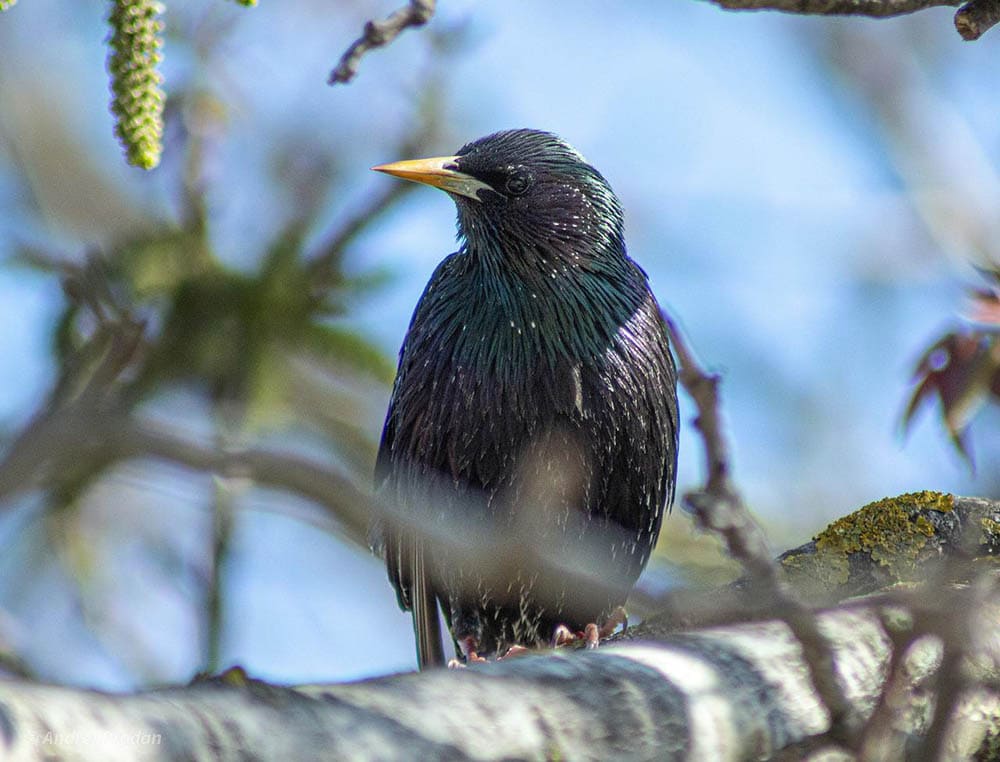
Birds play a crucial role in ensuring that the ecosystem stays in check. According to ornithologists, birds are incredible pollinators and the reason why native plants keep growing. Without them, these plants wouldn’t be able to disperse their seeds, or even survive.
If you take a closer look at the food chain, you’ll realize that they also act as natural pest control.
When it comes to brain science and cognitive psychology, several studies have shown that birdwatching can boost mental health1. Just watching the birds have fun while flying around is enough to force the brain to release “happy hormones2” that boost your mood.
The State of Texas is home to many bird species that would happily visit you, should you invite them. In this article, we’ll list the 20 most common backyard birds in Texas:

The 20 Most Common Backyard Birds in Texas
1. Northern Cardinal
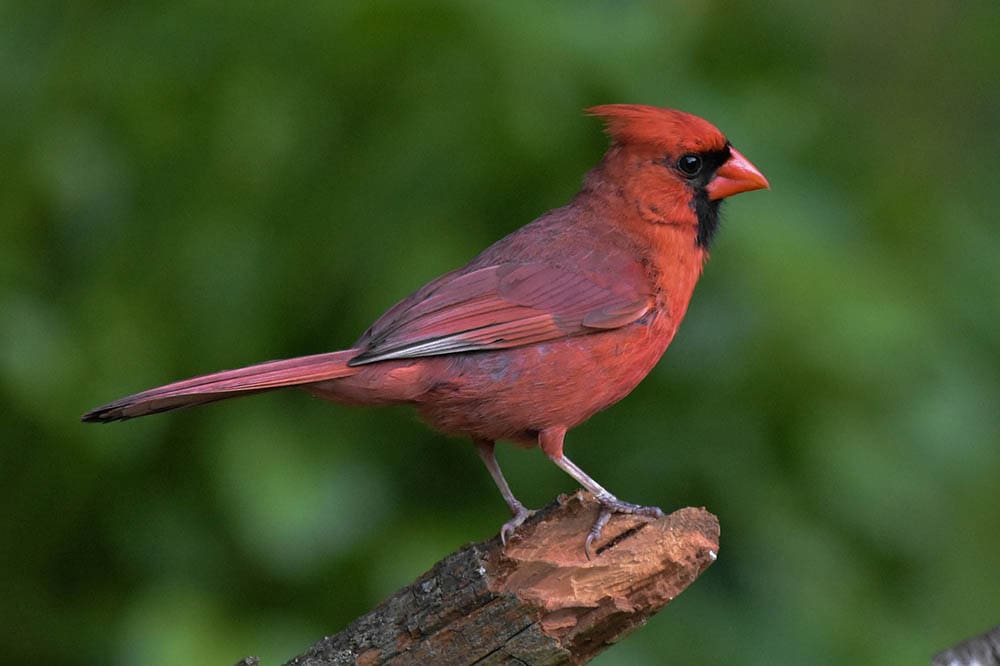
| Scientific Name: | Cardinalis cardinalis |
| Weight: | 1.5–1.7 oz |
| Length: | 7–9 inches |
The cardinals are a common species in the U.S. Most of them have built homes in the Great Plains, Gulf States, and the Northeastern side of the Canadian border. Most states have listed them as year-round residents, but that’s not surprising seeing as they are non-migratory.
If you want the Northern Cardinal to pay you a visit, you’ll have to offer them the food they like. They are largely seed-eating birds, but picky to an extent. You’ll never find them devouring striped seed varieties when seeds like black oil sunflower seeds are on the table.
Black oil sunflower seeds have always been their preferred meal, as they provide relatively more calories and energy.
2. Northern Mockingbird
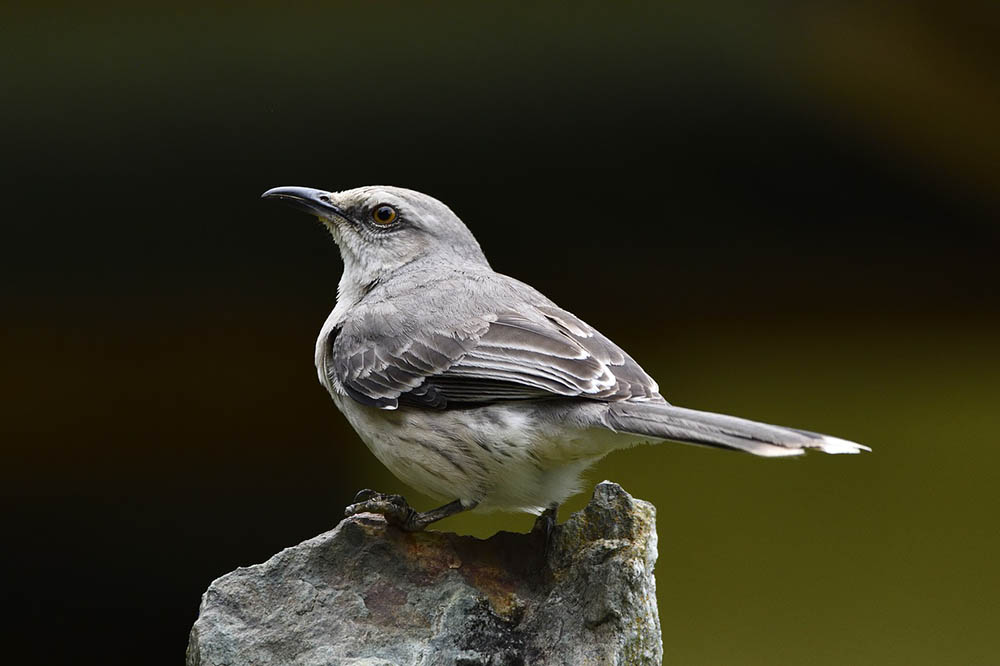
| Scientific Name: | Mimus polyglottos |
| Weight: | 1.4–2 oz |
| Length: | 8.1–11 inches |
As you might have guessed, the Northern Mockingbird is a songbird. But not all songbirds belong to the same family. This songbird belongs to the Mimidae family. Other species that belong to this family include New World Catbirds, Tremblers, and Thrashers.
The Northern Mockingbird is omnivorous, but most of their prey consists of invertebrates. You’ll find them hunting moths, worms, flies, beetles, etc. If they feed on greens they’ll prefer seeds, grapes, berries, and even figs.
It’s important to note that it’s illegal to hunt down or trap a Mockingbird in the United States.
3. Mourning Dove
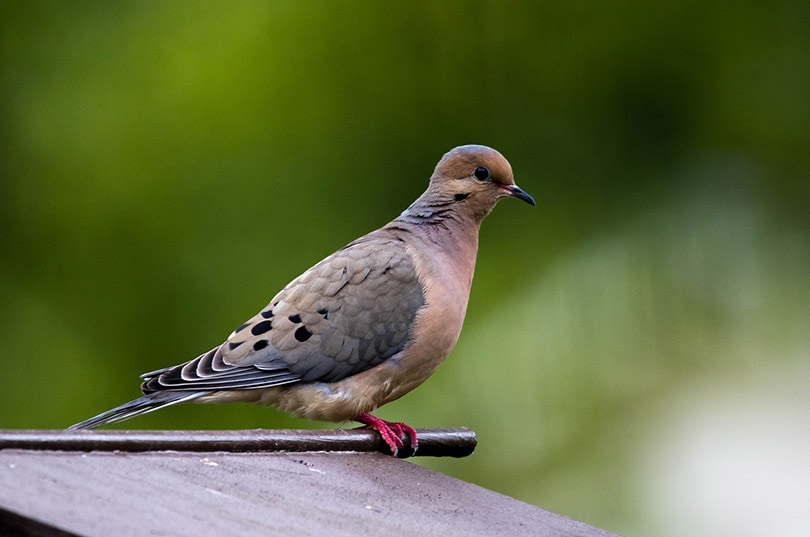
| Scientific Name: | Zenaida macroura |
| Weight: | 4.0–6.0 oz |
| Length: | 9.1–13.4 inches |
Identifying a Mourning Dove is easy. They often produce a mourning cooing sound that’s unique to them. We know luring them to your yard won’t be a problem because they’re practically foodies. It is estimated that they eat 12% to 20% of their total body weight every day. That’s approximately 71 calories on average.
Don’t try to feed them insects, though, they only feed on seeds and nothing else.
When you see a Mourning Dove grab seeds off the ground, you’ll think it’s feeding. But that’s not always the case, since they stockpile more than they feed. All that food goes into their body, into something called the crop. And it will stay there until the bird is ready for the next meal.
4. White-Winged Dove
https://www.instagram.com/p/CdJvT2xPgC0/
| Scientific Name: | Zenaida asiatica |
| Weight: | 4.0–6.0 oz |
| Length: | 10–12 inches |
White-Winged Doves prefer living in the desert. Yes, they do need water just like every other living organism, and that’s why they sometimes fly 25 or more miles in search of water. If there are no water bodies close by, they’ll settle for a saguaro cactus fruit. The moisture found in these plants is just enough to keep them going.
This species likes to migrate in packs. So if you see them, and you’d like to have them build a home in your backyard, just grow desert willow trees, cacti, organ-pipe, or agave. They really love those.
5. Blue Jay
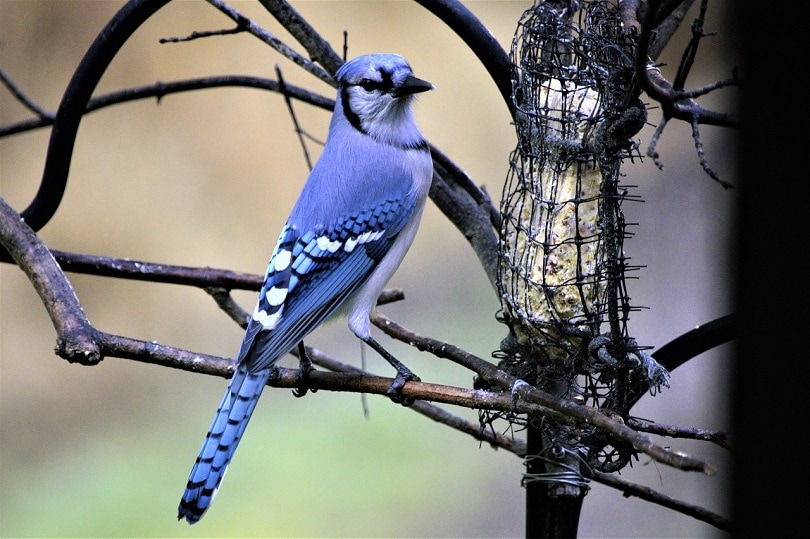
| Scientific Name: | Cyanocitta cristata |
| Weight: | 2.5–3.5 oz |
| Length: | 13–17 inches |
Unlike other species, Blue Jays don’t fear interacting with humans. That’s why you’ll find them building homes at the forest edges instead of going deep inside. They also love hanging around towns and neighborhoods.
If we’re talking about their preferred diet, we would say they are adventurous eaters. Blue Jays forage seeds on the ground, eat nuts, insects, and even dead or injured animals. We see them as risk-takers at times because they’ll have no problem raiding nests in search of eggs, nestlings, or even adult birds that barely escaped from their predators.
6. Carolina Chickadee
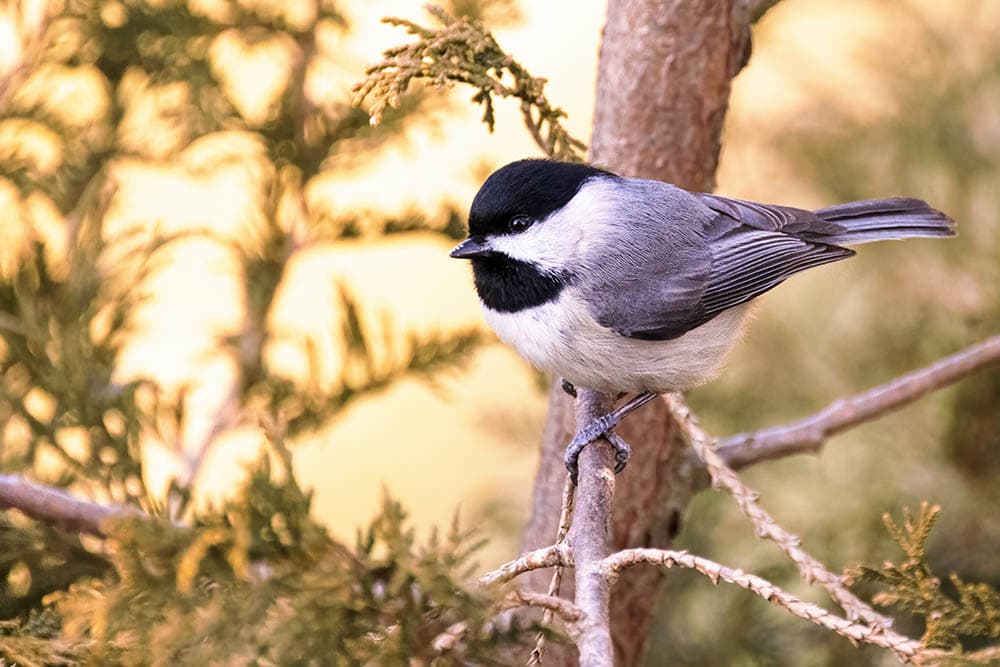
| Scientific Name: | Poecile carolinensis |
| Weight: | 0.3–0.4 oz |
| Length: | 3.9–4.7 inches |
If you’ve ever seen a tiny, inquisitive songbird that comes in white, gray, and black feathers, chances are you’ve seen a Carolina Chickadee. Just don’t be fooled by how small they are. They might look cute from a distance, but when you start moving too close for their comfort, they’ll certainly attack. This species is so fearless that it won’t think twice about going head-to-head with a snake, hawk, or owl.
Carolina’s diet will depend on the season. During winter, they mostly feed on plant-based foods. Just the usual stuff like seeds, berries, fruits, etc. And that’s also the time of year that they like visiting backyard bird feeders.
In the summer, you’ll find them looking for caterpillars, beetles, flies, spiders, and several other invertebrates that fit the profile.
7. Carolina Wren
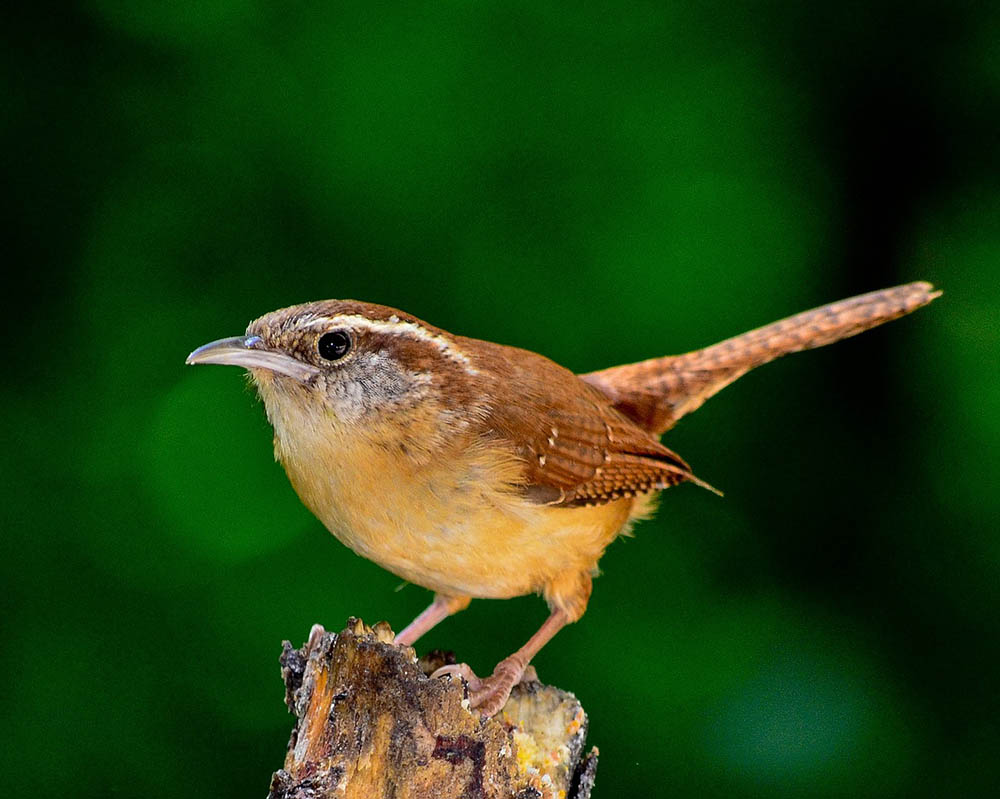
| Scientific Name: | Thryothorus ludovicianus |
| Weight: | 0.63–0.81 oz |
| Length: | 4.9–5.5 inches |
The Carolina Wren species should not be confused with the House Wren. The latter always has a shorter tail and a denser shade of brown. You’ll also never find a stripe next to its eyebrow or one that has a white chest.
Carolina Wrens prefer hanging out in vegetated habitats. And by vegetated, we mean habitats typically defined by woods and brushy thickets. Spotting them will be difficult as they are shy birds, but if you listen carefully, you’ll hear teakettle-teakettle sounds. A clear indication that they are close by.
They love spiders and insects more than anything, and only consume plants if their stores are running low.
8. House Sparrow

| Scientific Name: | Passer domesticus |
| Weight: | 0.85–1.39 oz |
| Length: | 0.63–0.98 in |
The House Sparrow is an invasive species for sure. There’s no doubt about that. It can cause ecological harm in any environment that it is not a part of. As a matter of fact, it is this behavior that has made some people loathe them.
You don’t have to go to the desert, forest, or in the wild to find a House Sparrow. You’ll always see one perched on top of buildings, or electric poles. They know they cannot survive far from humans, so they hang around cities and towns.
They usually feed on insects during summer, if they can’t gain access to crops or seeds such as sorghum, milo, oats, and millet.
9. European Starling

| Scientific Name: | Sturnus vulgaris |
| Weight: | 2.1–3.4 oz |
| Length: | 8.0–9.0 inches |
These are not the birds to attract if you’re a farmer. Of course, they’ll help you take care of your pest problem. But once they realize the pest population is dwindling fast, they’ll turn to your crops. They’ll damage the crops and eat anything that looks like a berry.
Unfortunately, your woes won’t end there. If you have other birds in the vicinity, they’ll drive them all away, without showing sympathy. European Starlings are naturally aggressive and gregarious.
10. Red-Winged Blackbird
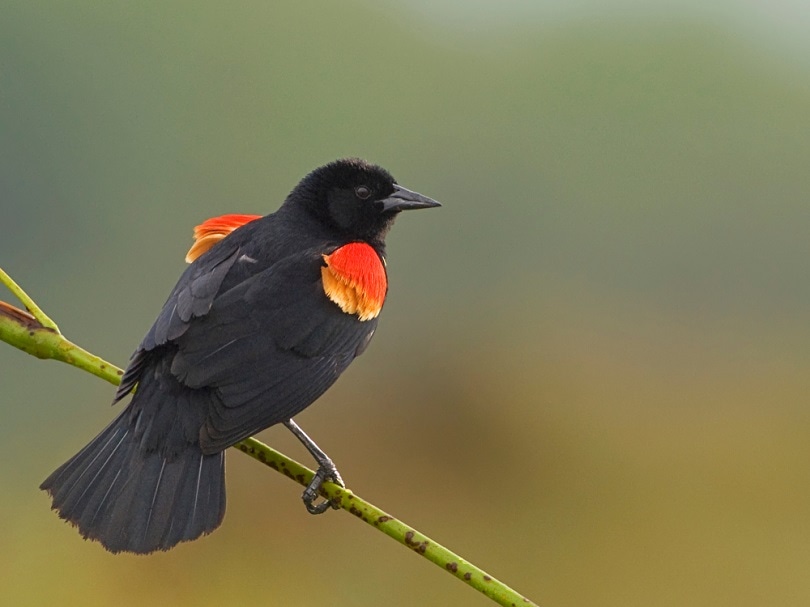
| Scientific Name: | Agelaius phoeniceus |
| Weight: | 2.0–2.9 oz |
| Length: | 3.2–5.7 inches |
In some cultures, people believe the Red-Winged Blackbird is a sign of good fortune. They also believe it symbolizes prosperity and protects families. We can’t confirm or deny those sentiments, but we can tell you that the Red-Winged Blackbird doesn’t have the best reputation in this part of the world. Most backyard birders don’t like how territorial they get, especially during their breeding season. They’ll attack other birds and make loud, obnoxious noises from time to time.
The sight of Red-Winged Blackbirds feeding is disconcerting, to say the least. But if you’d love to have them, just fill your feeders with hulled or black oil sunflower seeds.
11. Eastern Phoebe
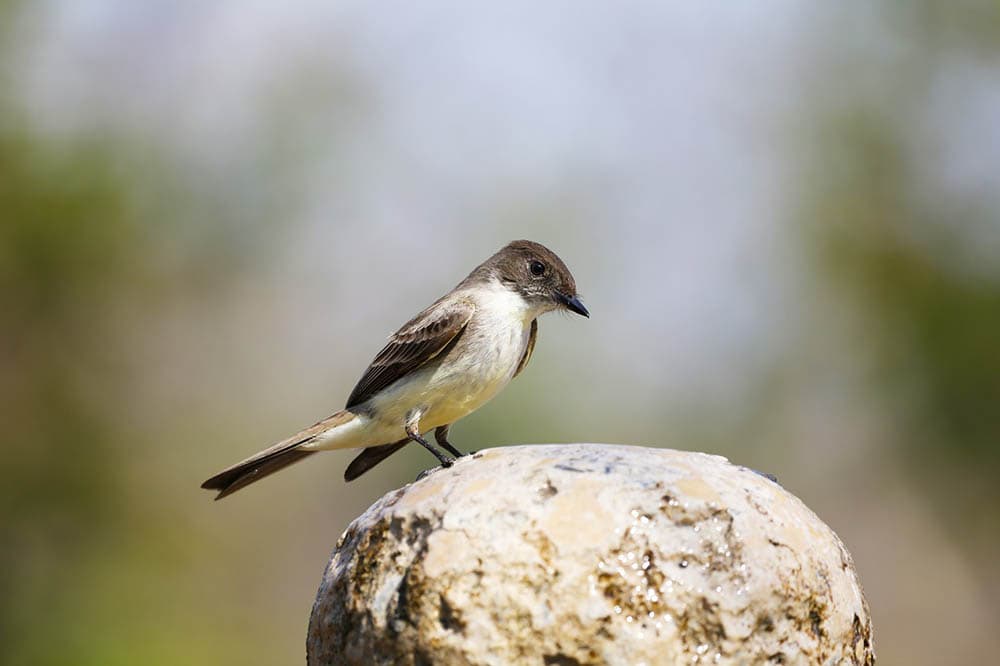
| Scientific Name: | Sayornis phoebe |
| Weight: | 0.6–0.7 oz |
| Length: | 5.0–6.0 inches |
The Eastern Phoebe is the kind of bird that will keep you company during summer, and then go MIA as winter approaches. That’s how we know they are migratory birds. According to the current records, they prefer breeding across the central and northeastern states, with some crossing the border to Canada.
Eastern Phoebes are a social species, but not so social that you’ll find them spending time in flocks or even as a pair. Their natural habitats are open quiet woodlands that have a dense population of flying insects. They also eat berries, seeds, and spiders.
12. Barn Swallow

| Scientific Name: | Hirundo rustica |
| Weight: | 0.6–0.7 oz |
| Length: | 5.5–7.0 inches |
The Barn Swallows are common in south, central, and North America. Ornithologists classify them as insectivores since their primary diet consists of insects. They spend most of their time flying over fields, farms, and meadows, searching for food. And if they are not in the mood to eat, they’ll be busy constructing nests on barns, or on structures that resemble barns. Safe to assume, that’s how they got their name.
Barn Swallows are relatively tiny, have a tail that looks like a fork, and a deep-blue color covering their whole back and wings. Their bellies are mostly white, and their faces have some reddish-brown streaks.
13. House Finch
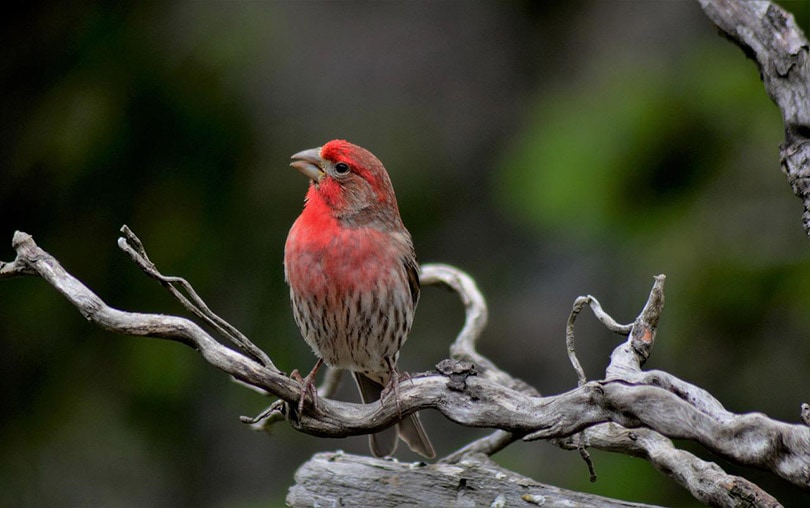
| Scientific Name: | Haemorhous mexicanus |
| Weight: | 0.6–0.9 oz |
| Length: | 5.1–5.5 inches |
We never used to have the House Finch in the eastern states. They only populated the western states because those were the regions that had the climate and the food they needed to survive. The change in climate is the reason why some of them have migrated to the east, and are doing so well. To be honest, they’ve done so well for themselves that their population has drastically increased. Consequently, pushing the Purple Finch species out.
Spotting a House Finch in the wild is not all that difficult. Just move closer to the forest edges and you’ll start hearing irritating noises from the branches. They’ll make those noises while feeding on bugs, seeds, or fruits. Fill your feeder trays with nyjer or black oil sunflowers seeds and they come running.
14. American Crow

| Scientific Name: | Corvus brachyrhynchos |
| Weight: | 11–21 oz |
| Length: | 16–20 inches |
American Crows had to be part of this list. We’ve all seen them in movies, so you don’t have to be told they are quite large and black. Several studies have shown how intelligent they are, especially when it comes to problem-solving.
Most often than not, they’ll be perched up high on a tree, just to get a bird’s eye view of what’s happening on the ground. If they spot or sense a predator approaching, they’ll produce a series of loud caws to let everyone know.
15. Western Kingbird
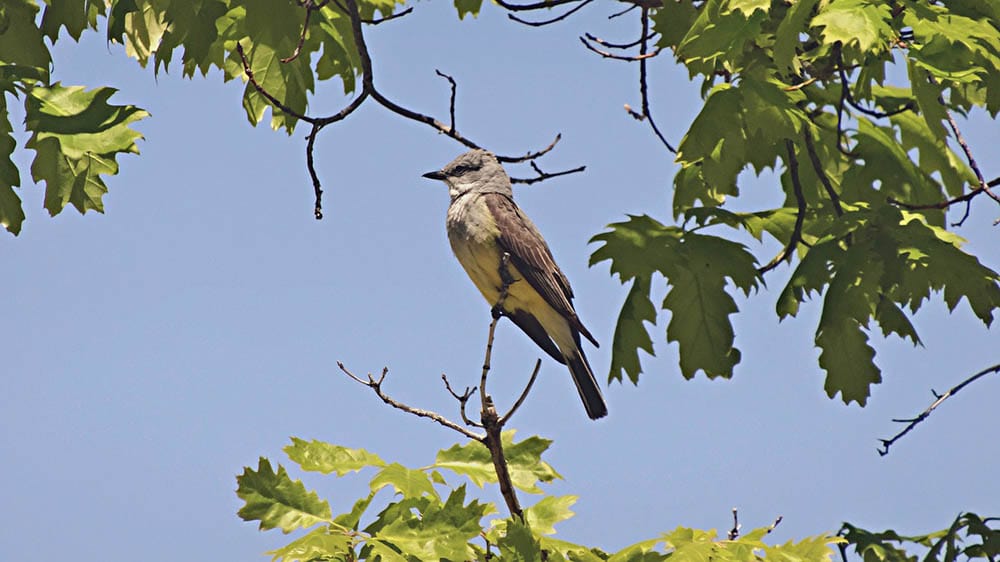
| Scientific Name: | Tyrannus verticalis |
| Weight: | 1.3–1.6 oz |
| Length: | 7.9–9.4 inches |
This species is one of the best flycatchers around. You’ll often see them perched on electric poles or utility lines, waiting for insects. A Western Kingbird will nest in trees or human-made structures. It doesn’t have a particular preference, as long as food is available and accessible.
It’s one of those yellow birds that breed in Texas during summer, before migrating south the minute the weather changes. You’ll find some of them in Central America and Mexico.
Attracting the Western Kingbird is easy. Just plant a few hawthorns or elderberries in your garden, and they’ll start showing up.
16. Orange-Crowned Warbler

| Scientific Name: | Vermivora celata |
| Weight: | 0.3–0.4 oz |
| Length: | 4.3–5.5 inches |
Warblers have been known to be brightly colored, but for reasons beyond our understanding, the Orange-Crowned Warbler isn’t. The yellow parts aren’t as yellow as you’d expect and the orange crown is barely visible.
They are mostly found in the western states and Canada during their breeding season, and in Mexico or southern states when they are not busy making kids. Their natural habitat is usually defined by low vegetation and shrubs. The diet chiefly consists of seeds, berries, fruits, caterpillars, spiders, fliers, and several other insects.
You can lure them using sugar water nectar, peanut butter, or suet.
17. Brown-headed Cowbird
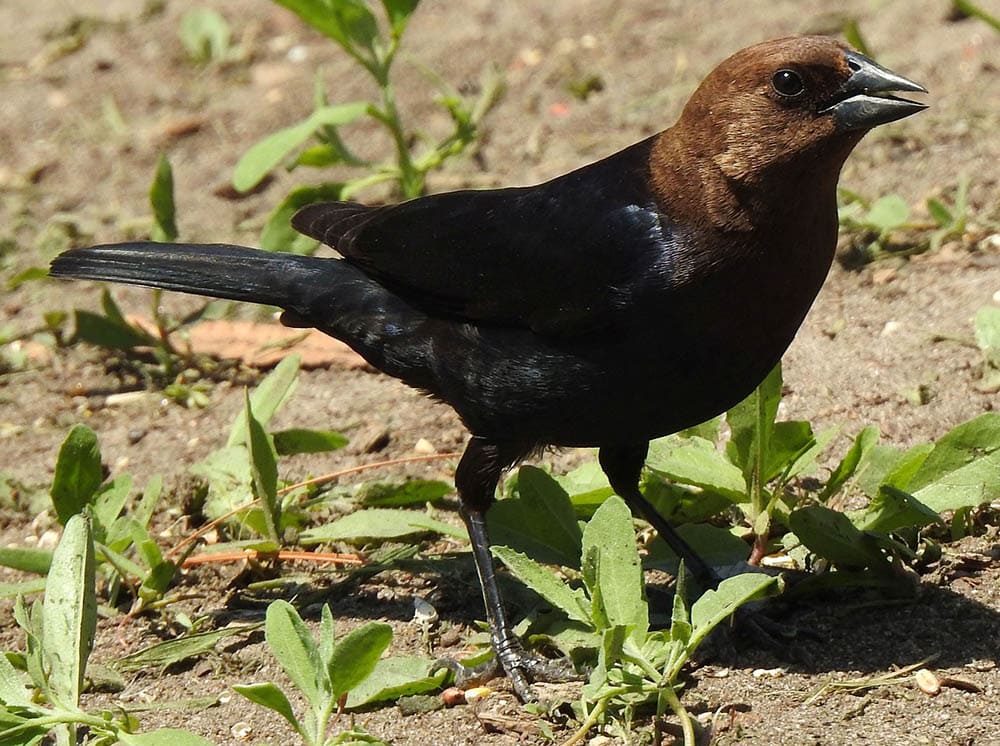
| Scientific Name: | Molothrus ater |
| Weight: | 1.5–1.8 oz |
| Length: | 7.5–8.7 inches |
Male Cowbirds have brown heads and darker bodies, while the females are consistently brown. These birds have been classified as brood parasites, meaning they’ll have other birds raise their young ones for them. They don’t normally build nests—but steal them. If they find any egg inside the structure, they’ll puncture it and then throw it out.
Most of them are on the Pacific Coast, but they’ll migrate to the western region of North America to breed.
18. Tufted Titmouse

| Scientific Name: | Baeolophus bicolor |
| Weight: | 0.6–0.9 oz |
| Length: | 5.5–6.3 inches |
The Titmouse bird is smaller compared to other species in this group, but very assertive. It’s common in Texas as it can be found in parks, and near the edges of forests. They’ll feed on insects in summer, and seeds, berries, or nuts during winter. The Tufted Titmouse is a hoarder as well and they’ve often been found hoarding shelled seeds.
They have no problem eating from suet, platform, or tube feeders. Serve them suet or sunflower seeds and they’ll build homes next to your home. And by the way, if you’re looking to lure a breeding pair, all you have to do is to put up a nest box.
19. Painted Bunting

| Scientific Name: | Passerina ciris |
| Weight: | 0.46–0.67 oz |
| Length: | 4.7–5.5 inches |
If birds had a clown among them, it would be the Painted Bunting. The males have so many bright colors on their bodies that resemble those of a clown. The belly and the rump are red, the wings are green, and the head is light blue. Their female counterparts are yellowish-green, but also very brightly colored.
Buntings prefer seeds, and they’ll only resort to feeding on insects if they can’t find seeds to eat.
20. Black-Crested Titmouse
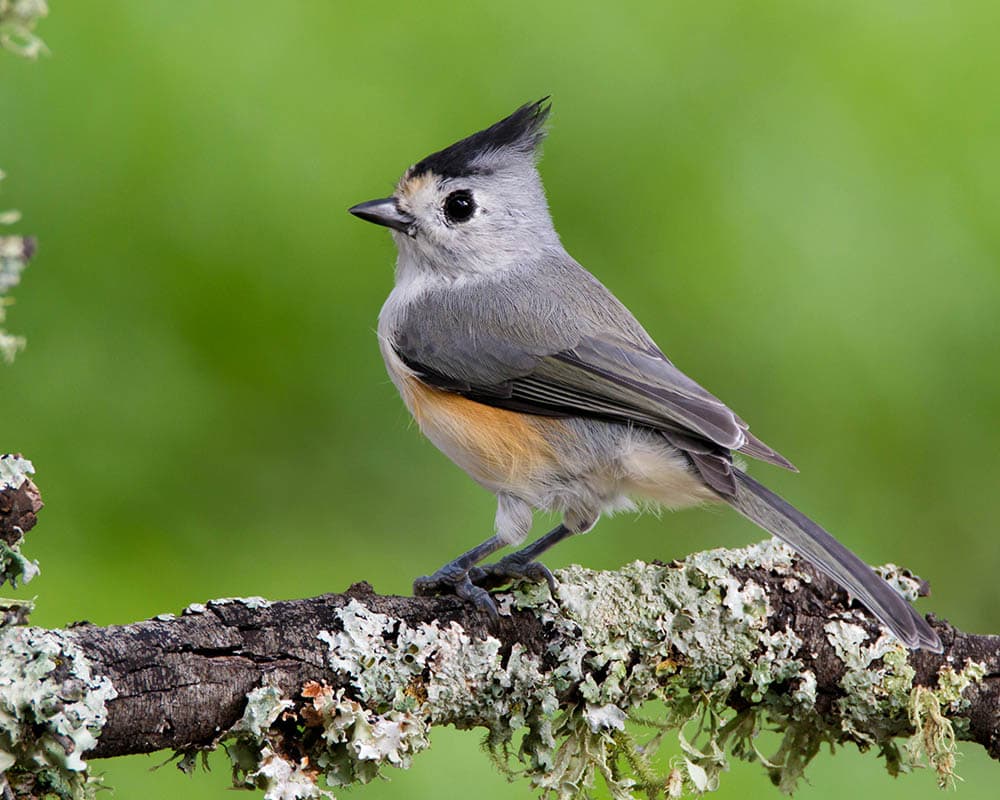
| Scientific Name: | Baeolophus atricristatus |
| Weight: | 0.5-0.7 oz |
| Length: | 9.1–11 inches |
The Black-Crested Titmouse is only found in Texas and Oklahoma. Identifying them is easy because they have a tiny mohawk that sets them apart. Their underbellies are white-ish, they have a dark patch on top of their bills, and have silver-gray backs. They love interacting with humans while feeding from backyard feeders.
This Titmouse species is similar to its cousins. It will eat insects together with eggs, berries, seeds, and nuts. Their breeding population is currently estimated to be a million, so don’t expect them to go extinct anytime soon.

In Conclusion
As you can see, Texas is home to some incredible bird species, and you don’t even have to leave your house to see them! Learn about their unique preferences to attract them to your backyard.
Featured Image Credit: andreiprodan, Pixabay
Table of Contents
- The 20 Most Common Backyard Birds in Texas
- 1. Northern Cardinal
- 2. Northern Mockingbird
- 3. Mourning Dove
- 4. White-Winged Dove
- 5. Blue Jay
- 6. Carolina Chickadee
- 7. Carolina Wren
- 8. House Sparrow
- 9. European Starling
- 10. Red-Winged Blackbird
- 11. Eastern Phoebe
- 12. Barn Swallow
- 13. House Finch
- 14. American Crow
- 15. Western Kingbird
- 16. Orange-Crowned Warbler
- 17. Brown-headed Cowbird
- 18. Tufted Titmouse
- 19. Painted Bunting
- 20. Black-Crested Titmouse
- In Conclusion
About the Author Robert Sparks
Robert’s obsession with all things optical started early in life, when his optician father would bring home prototypes for Robert to play with. Nowadays, Robert is dedicated to helping others find the right optics for their needs. His hobbies include astronomy, astrophysics, and model building. Originally from Newark, NJ, he resides in Santa Fe, New Mexico, where the nighttime skies are filled with glittering stars.
Related Articles:
Monocular vs Telescope: Differences Explained (With Pictures)
10 Types of Hummingbirds in Arkansas (With Pictures)
8 Types of Hummingbirds in Nebraska (With Pictures)
5 Types of Hummingbirds in Idaho (With Pictures)
3 Types of Hummingbirds in Mississippi (With Pictures)
8 Types of Hummingbirds in Kansas (With Pictures)
5 Types of Hummingbirds in West Virginia (With Pictures)
5 Types of Hummingbirds in Ohio (With Pictures)
